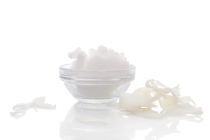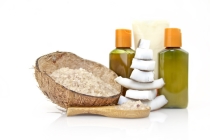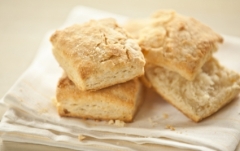 Everyone is talking about coconut oil! Dr. Oz, many naturopathic doctors and holistic nutritionists are proponents of eating coconut oil. While, both the Canadian and US Dietary Guidelines and other traditional medical sources like the Diabetes Associations suggest that the consumption of coconut oil, which is high in saturated fat, be limited in our diets. The controversy over the benefits of coconut oil will slowly be settled with more research and as more data become available through long-term studies.
Everyone is talking about coconut oil! Dr. Oz, many naturopathic doctors and holistic nutritionists are proponents of eating coconut oil. While, both the Canadian and US Dietary Guidelines and other traditional medical sources like the Diabetes Associations suggest that the consumption of coconut oil, which is high in saturated fat, be limited in our diets. The controversy over the benefits of coconut oil will slowly be settled with more research and as more data become available through long-term studies.
If you are interested in reading some of the research, please visit the following sites:
- http://www.coconutresearchcenter.org/Coconut%20Research-Coconut%20Research%20Center.pdf
- http://www.ncbi.nlm.nih.gov/pubmed (in search box type in “coconut oil health benefits”)
As you can tell from many of our recipes, we are fans of the product and have used it in many of our dishes to substitute butter or other shortening. Remember that moderation is important for any wholesome eating lifestyle.
What is Coconut Oil?
It is the edible oil that is extracted from the kernel or meat of matured coconuts. The oil is used in various applications including food, cosmetics and medicine.
There are different types of coconut oil including:
- Virgin, which contains all the nutrients;
- Refined, which is bleached and deodorized; and
- Hydrogenated, which is artificial.
Coconut oil is 90% saturated fat, which means that it remains in a solid state at room temperature. However, 50% of fat in coconut oil is lauric acid, which is a Medium Chain Fatty Acid/Triglycerides (known as MCT).
You might be thinking, “Why is coconut oil good for you if we’ve been told to stay away from saturated fats?” Proponents point out that the saturated fat found in coconut oil is different than other saturated fat found in meat or other vegetable oils. Our bodies metabolize or process fats differently depending on their chain size (or number of carbon atoms that make up the fatty acid).
How We Process Fatty Acids/Triglycerides: Long Chain versus Medium Chain
Long Chaim Fatty Acids (LCFAs) go through the stomach and into the intestinal tract where most of their digestion occurs. In order for digestion of LCFAs to happen, we need pancreatic digestive enzymes and bile. Pancreatic digestive enzymes and bile work on the LCFAs to break it down into individual fatty acids, which are then absorbed into the intestinal wall and transformed into little bundles of fat called lipo proteins. These lipo proteins circulate through the bloodstream releasing particles of fat, which becomes the source of the fat that collects in our fat cells.
Medium Chain Fatty Acids (MCT) are digested very easily. When they enter the intestinal tract, they have already completed their digestion and have been broken down into individual fatty acids. Unlike LCFAs, they don’t need pancreatic enzymes or bile to break them down. Because they are already broken down into individual fatty acids they are absorbed immediately into the portal vein and sent directly to the liver, which uses this fat to produce energy. MCTs bypass the lipo protein stage in the intestinal wall; therefore, they do not circulate into the bloodstream to the extent that other fats do and as a result do not contribute to collecting fat in our fat cells. Bottom line, MTCs are used for energy and not body fat.
 Health Properties and Uses
Health Properties and Uses
Coconut oil:
- Is antibacterial, antiviral, antiprotozoa, and antioxidant.
- Has a high melting point so you can use it for high heat cooking.
- Turns liquid at about 76 degrees.
- Does not require refrigeration.
Coconut oil may be beneficial in:
- Supporting thyroid health
- Promoting weight loss
- Supporting heart and brain health
- Treating Fungal infections (nails, worms)
- Soothing and/or treating skin outbreaks such as eczema, acne, insect bites, skin infections, sunburns
- Using as skin moisturizer, hair conditioner, shaving lotion, sunscreen
Easy Recipes
Coconut oil can be used in a number of dishes to give flavor and moisture. For example:
- mix a teaspoon in your morning oatmeal,
- use it instead of butter in mashed potatoes and pop corn,
- include a teaspoon or two in your coffee or hot chocolate,
- use in baking sweet and savory foods,
- mix into soups and use to saute vegetables.
The following are a couple of great recipes that include coconut oil.
From Whole Foods Marketplace:
We love scones or biscuits and this recipe is a great way to take in your coconut oil boost!
From The Nourishing Gourmet:
We have tried this recipe and it is very good. The fudge melts in your mouth! For people expecting the super sweet taste, they may be surprised as this recipe contains little sugar and sprinkling some sea salt will cut down the sweetness further.
Looking for other coconut recipes? Then visit the following site:
http://www.freecoconutrecipes.com/index.htm
References:
- http://www.coconutresearchcenter.org/Coconut%20Research-Coconut%20Research%20Center.pdf
- http://www.coconutresearchcenter.org/

















Great post.
LikeLike
I used to be recommended this blog through my cousin. I’m not sure whether or not
this publish is written through him as no one else realize such certain approximately my problem.
You’re incredible! Thank you!
LikeLike
Appreciating the time and energy you put into your blog and in depth information you
present. It’s good to come across a blog every once in a while that isn’t the same unwanted rehashed material.
Wonderful read! I’ve saved your site and I’m adding your RSS
feeds to my Google account.
LikeLike
Thank you, Kevin!
LikeLike
Have you ever considered about adding a little bit more than just your articles?
I mean, what you say is valuable and all. Nevertheless think about
if you added some great photos or video clips
to give your posts more, “pop”! Your content is excellent but with images
and video clips, this website could certainly be one of the
very best in its field. Great blog!
LikeLike
It’s impressive that you are getting thoughts from this paragraph as well as from our dialogue made at
this place.
LikeLike
I was wondering if you ever considered changing the page layout of your website?
Its very well written; I lovee what youve got tto say.
But maybe you could a little more in the way of content so people couod connect with it better.
Youve got an awful lot of text for only having 1 or two images.
Mayb you could space it out better?
LikeLike
I love what you guys tend to be up too. This sort of clever work and exposure!
Keep up the excellent works guys I’ve incorporated you guys to my own blogroll.
LikeLike
Hello there! This is my first visit to your blog!
We are a group of volunteers and starting a new project in a
community in the same niche. Your blog provided us beneficial information to work on. You have done a extraordinary
job!
LikeLike
Hi there everyone, it’s my first pay a quick visit
at this site, and article is in fact fruitful designed
for me, keep up posting such articles or reviews.
LikeLike
Pingback: Monthly Food Feature: Coconut | Aspire, Perspire, Nourish Yourself